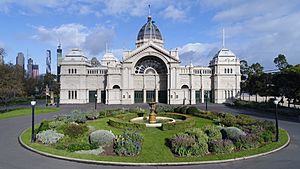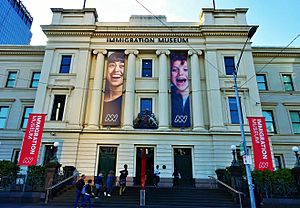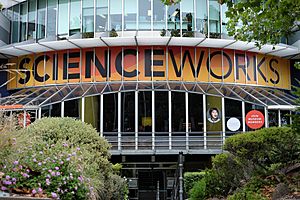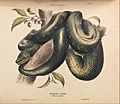Museums Victoria facts for kids

Melbourne Museum: Museums Victoria's main campus
|
|
| Former name | Museum of Victoria, Museum Victoria |
|---|---|
| Established | 1854 |
| Location | Melbourne, Victoria, Australia |
| Type | Natural history, cultural history, and science and technology |
| Founder | Frederick McCoy |
Museums Victoria is an organisation which operates three major state-owned museums in Melbourne, Victoria, the Melbourne Museum, the Immigration Museum and Scienceworks Museum. It also manages the Royal Exhibition Building and a storage facility in Melbourne's City of Moreland.

History
The museum traces its history back to the establishment of the "Museum of Natural and Economic Geology" by the Government of Victoria, William Blandowski and others in 1854.
The Library, Museums and National Gallery Act 1869 incorporated the Museums with the Public Library and the National Gallery of Victoria; but this administrative connection was severed in 1944 when the Public Library, National Gallery and Museums Act came into force, and they became four separate institutions once again.
Museums Victoria was founded in its current form under the Australian Museums Act (1983). Currently, Museums Victoria's State Collections holds over 17 million items, including objects relating to Indigenous Australian and Pacific Islander cultures, geology, historical studies, palaeontology, technology & society, and zoology Museums Victoria also contains a library collection that holds some of Australia’s rarest and finest examples of 18th and 19th century scientific monographs and serials.
Significant events in the Museum's history include:
- 1854 – Founding of the "Museum of Natural and Economic Geology" by William Blandowski and others; Blandowski oversees the museum
- 1856 – Collections moved to the University of Melbourne in Parkville by Frederick McCoy
- 1858 – McCoy appointed first "director" of the museum
- 1862 – New building opens on University site, museum renamed "National Museum of Victoria"
- 1869 – National Museum, embryotic Industrial & Technological (I&T) Museum, National Gallery of Victoria (NGV) and Public Library of Victoria merged into a single body
- 1870 – I&T Museum opened on Swanston Street site (behind the Public Library)
- 1893 – I&T Museum opens new building on Russell St as part of Library complex
- 1899 – National Museum moved to I&T Museum's building, and takes over it's mineral collection; rest of I&T Museum put into storage
- 1915 – I&T Museum reopens in Library's now surplus Queens Hall, thanks largely to George Swinburne and John Monash
- 1927 – National Museum acquired the H. L. White Collection of Australian native bird eggs
- 1944 – Museums organisationally re-separated from Library, NGV and each other; all remain in one building
- 1945 – I&T Museum renamed Museum of Applied Science (MAS)
- 1946 – MAS takes over Melbourne Observatory
- 1969 – NGV moves to St Kilda Rd, MAS moves into it's old buildings, Library gets back Queens Hall
- 1961 – Museum of Applied Science renamed Institute of Applied Science
- 1971 – Institute of Applied Science renamed Science Museum of Victoria
- 1981 – Museum Station opened, providing train services
- 1983 – National Museum of Victoria and Science Museum of Victoria amalgamated to form the Museum of Victoria (NMV)
- 1992 – Scienceworks opened in Spotswood
- 1997 – Swanston Street campus closed
- 1998 – Museum of Victoria renamed Museum Victoria; Immigration and Hellenic Antiquities Museum opened
- 2000 – Melbourne Museum at Carlton Gardens opened
- 2016 – Museum Victoria renamed Museums Victoria
Administration
The present chief executive officer of Museums Victoria is Lynley Crosswell (formerly Marshall), who was previously the head of the Australian Broadcasting Corporation’s international arm. Crosswell is the first woman to lead the organisation in its history.
Former directors include:
- 1858 – Frederick McCoy
- 1899 – Walter Baldwin Spencer
- 1928 – James A. Kershaw
- 1931 – Daniel James Mahony
- 1957 – Charles. W. Brazenor
- 1962 – John McNally
- 1979 – Barry Wilson
- 1984 – Robert Edwards
- 1990 – Graham Morris
- 1998 – George F. MacDonald
- 2002 – Dr J. Patrick Greene
Library
The Museums Victoria Library collection was first established in the 1850s as a working collection for the Museum's curators, and has developed into one of the best collections of natural history books and journals in Australia. The library was located at Melbourne University until 1906 when it moved, with the museum, to be co-located with the Public Library.
Today, the library collection is located at Melbourne Museum and contains 40,000 titles, which includes around 1,000 titles that are considered to be rare due to one or a combination of factors, including: value; scarcity; aesthetic qualities; historic, scientific or institutional significance; fragility; or age. Collection strengths include natural history in the fields of zoology, geology and palaeontology, scientific expedition reports, society and institutional journal titles, Indigenous cultures of Australia and the Pacific, Australian history, technology, colonial and other exhibition catalogues, museum studies, and Museums Victoria publications.
Many items from the Museums Victoria Library have been digitised for the Biodiversity Heritage Library as Museums Victoria is the home to the Australian node of this project. The digitisation operation is hosted by Museums Victoria and is nationally funded by the Atlas of Living Australia.
- Some significant works held in the Museums Victoria Library collections
-
A double plate from Albertus Seba's Thesaurus
-
Plate 8 from Zoology of New Holland by George Shaw
-
Illustration of a potoroo from Voyage autour du monde by Louis de Freycinet
-
Granulated Cuttle illustration from The Naturalist's Miscellany by George Shaw
-
Illustrated plate from On the marsupial pouches, mammary glands and mammary foetus of the Echidna hystrix by Richard Owen










